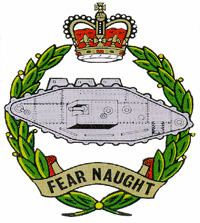 | ||
The 3rd Royal Tank Regiment (3 RTR) was an armoured regiment of the British Army in existence from 1917 until 1992. It was part of the Royal Tank Regiment, itself part of the Royal Armoured Corps. It originally saw action as C Battalion, Tank Corps in 1917.
History
In 1916 the Machine Gun Corps formed a Heavy Section, later Branch, in order to crew the first tanks. C Company was formed at Bisley and sent to France, after offensives in 1916 the Heavy Section became the Heavy Branch and "C" Company was expanded to Battalion strength. The Heavy Branch was then reformed in to a new Tank Corps and "C" Battalion then fought from Cambrai to the end of the war, being re-equip with Whippet tanks in 1918. Lieutenant CH Sewell won the Battalion's only Victoria Cross for an outstanding act of bravery at Fremingcourt in August of that year.
Post war, the Tank Corps was trimmed down and received the Royal prefix with the lettered battalions being numbered and "C" became 3rd Royal Tank Corps. In 1939 the 3 RTR was retitled from "3rd Royal Tank Corps" during the formation of the Royal Armoured Corps encompassing the old RTC and all horse cavalry units which had converted to armour.
With the outbreak of the Second World War the army was once more deployed to France. In 1940, 3 RTR was preparing for deployment as part of 1st Armoured Division when it was diverted at short notice to Calais. Here it fought during the four-day Siege of Calais, part of the Battle of France. All of its tanks were lost, and many personnel were killed or taken prisoner, but some escaped to Dunkirk or were evacuated from Calais before the port fell.
The regiment was subsequently rebuilt in the United Kingdom as part of 3rd Armoured Brigade, its original parent formation. Shipped to the Middle East, it was part of the 1st Armoured Brigade when it was sent to defend Greece to try to stem the German invasion in 1941.
From May to mid November 1941, there was a period of reorganisation in Egypt. During this time, substantial reinforcements of both men and tanks (mostly American M3 Stuarts) were received to replace the losses incurred in Greece. From the 17th of November until the end of the year, 3 RTR took part in Operation Crusader.
In 1942, it briefly amalgamated with the 5th Royal Tank Regiment, as the 3rd/5th Royal Tank Regiment, returning to its previous title a month later. It was then attached to 8th Armoured Brigade, fighting at El Alamein, and in Tunisia.
3 RTR was transferred back to the UK in late 1943 joining 29th Armoured Brigade and fought in Normandy, the Netherlands and Germany as part of 11th Armoured Division.
During the Battle of the Bulge in 1944, 3 RTR was sent to form part of the defensive line on the Meuse river. Its tanks met the vanguard of the German push to the river before the panzers were turned back.
After the war in 1959, it amalgamated with the 6th Royal Tank Regiment without change of title and was used as the RAC training regiment until 1967 when it was moved to an armoured reconnaissance role. The regiment then alternated back and forth from the UK to Germany until 1971 when it was returned to an armoured battalion.
Elements of the 3RTR served in Cyprus as part of the UN peacekeeping efforts there after the 1974 invasion. While the remainder of the Regiment again served as a training unit.
In 1979 the regiment was returned to Germany and remained based in Hemer with operational deployments to Ireland, Saudi Arabia and the Gulf.
In the summer of 1989 the 3rd Royal Tank Regiment was deployed to Northern Ireland in an infantry role, the first armoured regiment to do so for many years.
In 1992, 3 RTR amalgamated with the 2nd Royal Tank Regiment under that name.
